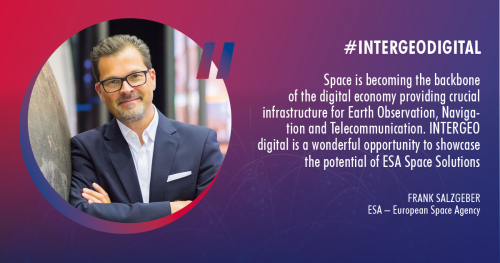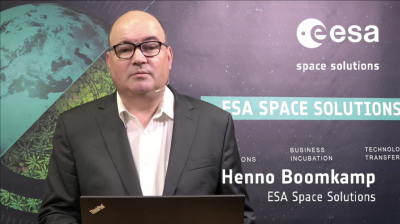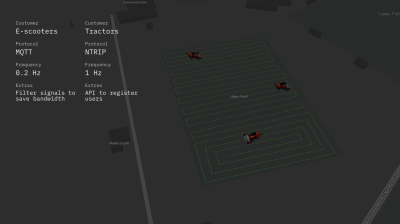Extraordinary situations warrant extraordinary measures. They can also have extraordinary results, as seen at INTERGEO Digital 2020 on 13-15 October, which was very successful despite being a fully online event.

Five companies from three ESA Business Incubation Centres (ESA BICs) were invited to have a presence at the ESA Space Solutions stand for INTERGEO 2020 in order to raise the profile of their businesses. In addition, five experts from ESA gave talks and interviews, including Nick Appleyard, Head of ESA Space Solutions, and Frank Salzgeber, Head of Innovation and Ventures Office, ESA.
The participating ESA BIC incubates were Drone Harmony and Fixposition from ESA BIC Switzerland, Precision Navigation Systems from ESA BIC Estonia, and ThingsOnAir and Vaireco from ESA BIC Hessen & Baden-Württemberg.
Over 1,200 participants visited the ESA Space Solutions digital stand, including the stands of the five ESA BIC start-ups – that’s 10 per cent of all participants.The success of the show can be seen in the numbers. Over three days at INTERGEO Digital, there were over 330,000 interactions at digital touchpoints. Around 12,000 participants from 153 countries each created a digital profile and viewed information on the exhibitors' pages, as well as convening via the video meeting rooms. INTERGEO Digital has never been as international as this year, showing that even in these difficult times, people are happy to embrace innovative new formats for events.

Martin Fuchsberger from Drone Harmony summarised the benefits of the shared ESA Space Solutions booth as “higher presence, credibility and visibility at a lower cost”, adding that “we benefited not only from a subsidised exhibition presence but also from the additional traction and visibility that the ESA BIC marketing generated.”
“Space is becoming the backbone of the digital economy, providing crucial infrastructure for Earth observation, navigation and telecommunications,” said Frank Salzgeber. “INTERGEO Digital was a wonderful opportunity to showcase the potential of ESA Space Solutions.”
ESA Space Solutions stand welcomes high-ranking experts from ESA
Frank Salzgeber was physically present at the INTERGEO Expo Lounge stage where he gave an interview. This broadcast was shown three times over the three days, with over 200 visitors stopping by to have a look. He also gave a presentation via the ESA Space Solutions stage from the new studio at Cesah (ESA BIC Hessen & Baden-Württemberg). The interview with Nick Appleyard was also livestreamed via the INTERGEO Expo Lounge Stage and attracted many visitors.



The ESA BIC incubated company Precision Navigation Systems gave a pitch during INTERGEO Digital in their digital meeting room, while Drone Harmony offered a live demo on
their sub-stand. Fixposition pitched on the EXPO stage. Henno Boomkamp (ESA Tech Transfer), Donata Pedrazzani (ESA BIC network) and Davide Coppola (ESA Space Solutions) completed the list of talks from ESA experts.
INTERGEO is the biggest trade show in the field of geoinformation; this is an area many ESA BIC start-ups are working in and therefore a perfect fit for ESA Space Solutions. Both the start-ups and Cesah (ESA BIC Hessen & Baden-Württemberg) are looking forward to attending the trade show again in 2021.
ABOUT ESA SPACE SOLUTIONS
ESA Space Solutions is the go-to-place for great business ideas involving space in all areas of society and economy. Our mission is to support entrepreneurs in Europe in the development of business using satellite applications and space technology to improve everyday life. Our programme is designed to provide multiple entry points such as ESA Business Incubation Centres (ESA BICs), ESA Technology Broker Network, and ESA Business Applications programme. Funding typically ranges from 50KEuro to 2MEuro and supports everything from space technology transfer, early stage incubation programs, Feasibility Studies to large-scale Demonstration Projects.
Posted to Hero article section
No









